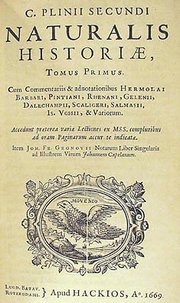Pliny's Natural History
|
|
Pliny the Elder's Natural History is an encyclopedia written by Pliny the Elder.
In its present form the Natural History consists of thirty-seven books, the first book including a characteristic preface and tables of contents, as well as lists of authorities, which were originally prefixed to each of the books separately. The contents of the remaining books are as follows:
II, mathematical and physical description of the world;
III - VI, geography and ethnography;
VII, anthropology and human physiology;
VIII - XI, zoology;
XII - XXVII, botany, including agriculture, horticulture and pharmacology;
XXVIII - XXXII, medical zoology;
XXXIII - XXXVII, mineralogy, especially in its application to life and art, including chasing in silver (xxxiii.154-751), statuary in bronze (xxxiv), painting (xxxv.15-941), modelling (151-851), and sculpture in marble (xxxvi).
He apparently published the first ten books himself in AD 77, and was engaged on revising and enlarging the rest during the two remaining years of his life. The work was probably published with little, if any, revision by the author's nephew, who, when telling the story of a tame dolphin, and describing the floating islands of the Vadimonian Lake, thirty years later (viii. 20, ix. 33), has apparently forgotten that both are to be found in his uncle's work (ii. 209, ix. 26). He describes the Naturalis historia, as a Naturae historia, and characterizes it as a "work that is learned and full of matter, and as varied as nature herself."
The absence of the author's final revision may partly account for many repetitions, and for some contradictions, for mistakes in passages borrowed from Greek authors, and for the insertion of marginal additions at wrong places in the text.
In the preface the author claims to have stated 20,000 facts gathered from some 2,000 books and from 100 select authors. The extant lists of his authorities amount to many more than 400, including 146 of Roman and 327 of Greek and other sources of information. The lists, as a general rule, follow the order of the subject matter of each book. This has been clearly shown in Heinrich Brunn's Disputatio (Bonn, 1856).
Pliny's principal authority is Varro. In the geographical books Varro is supplemented by the topographical commentaries of Agrippa which were completed by the emperor Augustus; for his zoology he relies largely on Aristotle and on Juba, the scholarly Mauretanian king, studiorum claritate memorabilior quam regno (v. 16). Juba is also his principal guide in botany. Theophrastus is also named in his Indices.
In the History of Art the original Greek authorities are Duris of Samos, Xenocrates of Sicyon, and Antigonous of Carystus. The anecdotic element has been ascribed to Duris (xxxiv. 61, Lysippum Sicyonium Duris Begat nullius fuisse discipulum etc.); the notices of the successive developments of art, and the list of workers in bronze and painters, to Xenocrates; and a large amount of miscellaneous information to Antigonus. The last two authorities are named in connection with Parrhasius (xxxv. 68, hanc ei gloriam concessere Antigonus et Xenocrates, qui de pictura scripsere), while Antigonus is named in the indices of xxxiii - xxxiv. as a writer on the toreutic art.
Greek epigrams contribute their share in Pliny's descriptions of pictures and statues. One of the minor authorities for books xxxiv - xxxv is Heliodorus, the author of a work on the monuments of Athens. In the indices to xxxiii - xxxvi an important place is assigned to Pasiteles of Naples, the author of a work in five volumes on famous works of art (xxxvi. 40), probably incorporating the substance of the earlier Greek treatises; but Pliny's indebtedness to Pasiteles is denied by Kalkmann, who holds that Pliny used the chronological work of Apollodorus, as well as a current catalogue of artists. Pliny's knowledge of the Greek authorities was probably mainly due to Varro, whom he often quotes (e.g. xxxiv. 56, xxxv. 173, 156, xxxvi. 17, 39, 41). Varro probably dealt with the history of art in connexion with architecture, which was included in his Disciplinae.
For a number of items relating to works of art near the coast of Asia Minor, and in the adjacent islands, Pliny was indebted to the general, statesman, orator and historian, Gaius Licinius Mucianus, who died before AD 77. Pliny mentions the works of art collected by Vespasian in the Temple of Peace and in his other galleries (xxxiv. 84), but much of his information as to the position of such works in Rome is due to books, and not to personal observation.
The main merit of his account of ancient art, the only classical work of its kind, is that it is a compilation ultimately founded on the lost text books of Xenocrates and on the biographies of Duris and Antigonus.
He shows no special aptitude for art criticism; in several passages, however, he gives proof of independent observation (xxxiv. 38, 46, 63, xxxv. 17, 20, 116 seq.). He prefers the marble Laocoon in the palace of Titus to all the pictures and bronzes in the world (xxxvi. 37); in the temple near the Flaminian Circus he admires the Ares and the Aphrodite of Scopas, "which would suffice to give renown to any other spot." "At Rome indeed (he adds) the works of art are legion; besides, one effaces another from the memory and, however beautiful they may be, we are distracted by the overpowering claims of duty and business; for to admire art we need leisure and profound stillness" (ibid. 26-72).
External links
- complete Latin text at LacusCurtius (http://penelope.uchicago.edu/Thayer/E/Roman/Texts/Pliny_the_Elder/home.html)
- First English translation by Philemon Holland, 1601; books 1‑3, 7‑13 online (http://penelope.uchicago.edu/holland/index.html)
- Second English translation by John Bostock and H. T. Riley, 1855; book 11 online (http://www.orditur-telas.com/pliny/) extracts about India from books 26-28 online (http://www.fordham.edu/halsall/ancient/pliny-india.html)de:Naturalis historia

